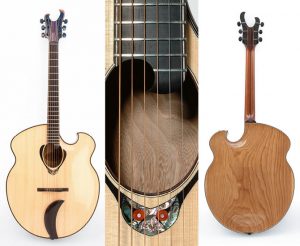So, you Want to Build your own Archtop?
 Building an archtop guitar is a challenging but rewarding project that requires a combination of woodworking skills, craftsmanship, and a good understanding of guitar construction.
Building an archtop guitar is a challenging but rewarding project that requires a combination of woodworking skills, craftsmanship, and a good understanding of guitar construction.
An archtop guitar is a type of acoustic or semi-acoustic guitar that features an arched top, which is carved or pressed into an arched shape. This design distinguishes archtop guitars from flat-top guitars. Archtops are known for their distinctive appearance, with a curved or “arched” top and back.
Key features of an archtop guitar include:
Arch-shaped Top
The top (or soundboard) of an archtop guitar is carved or pressed into an arched shape. This arch contributes to the guitar’s resonance, tone, and projection. Archtop guitars typically have F-shaped sound holes (similar to those found on violins) on the top. These F-holes not only contribute to the guitar’s aesthetics but also play a role in shaping the instrument’s sound.
Curved Back
The back of the archtop guitar is also curved, complementing the arched top. This design adds to the guitar’s resonance and contributes to the distinctive tonal qualities associated with archtops. Archtops can be fully hollow or semi-hollow. Fully hollow archtops have no solid block of wood running through the body, while semi-hollow archtops have a block running through the center of the body to reduce feedback at higher volumes. Archtops often feature a tailpiece and bridge design. The tailpiece anchors the strings, and the bridge is usually floating or attached to the top, allowing for adjustments to the action. Archtop guitars are commonly associated with jazz music. Their warm, resonant tones and excellent projection make them suitable for jazz guitarists, though they are versatile enough for other genres as well.
High-Quality Materials
Archtop guitars are often crafted using high-quality tonewoods such as spruce for the top and maple for the back and sides. The use of these tonewoods, along with the arched design, contributes to the instrument’s unique sound. Renowned guitar manufacturers like Gibson and Epiphone have produced iconic archtop models, including the Gibson L-5 and ES-175. Players such as Wes Montgomery and Joe Pass are famous for their use of archtop guitars in jazz music. The craftsmanship required to build an archtop guitar and its distinctive features contribute to its reputation as a high-end and specialized instrument.
If you want to build your own archtop, here is the process
1. Design
Choose a design for your archtop guitar. Consider factors such as body shape, scale length, and the type of wood you want to use. Acquire or create detailed plans for your chosen design.
2. Gather Materials
Select high-quality tonewoods for the top, back, sides, and neck. Common choices include spruce or cedar for the top and maple for the back and sides.
Choose an appropriate fingerboard material (e.g., ebony or rosewood) and select hardware such as tuners, bridge, and tailpiece.
3. Tools and Equipment
Acquire the necessary tools for guitar building, including chisels, planes, saws, rasps, and clamps. You may need specialized tools for carving the arch, like a bending iron for shaping the sides.
4. Building Process
Start by rough-cutting the body and neck blanks from your chosen tonewoods. Use the plans to shape the top and back with the desired arch. This can involve carving, graduating, and refining the thickness of the wood. Bend the sides to the desired shape using a bending iron. Glue the top and back onto the sides, then shape and carve the braces inside the guitar to enhance its structural integrity and tonal characteristics. Attach the neck to the body and carve the neck profile. Install the fingerboard, frets, and headstock. Apply a finish to protect and enhance the wood. Remember to protect your airway from the spray.
5. Assembly
Assemble all the components, including attaching the bridge, tailpiece, and tuners. Install the nut and set up the guitar for proper playability by adjusting the action and intonation.
6. Finishing Touches
Sand the entire instrument to achieve a smooth finish. Apply a suitable finish (e.g., lacquer, varnish, or oil) to protect the wood and enhance its appearance.
7. Setup
Adjust the truss rod, bridge height, and nut slots to achieve the desired playability. Install strings and perform final adjustments to ensure proper intonation and playability.
8. Testing and Adjusting
Play the guitar and make any necessary adjustments to the setup for optimal playability and tone. Fine-tune the nut and saddle for proper string action.
Building an archtop guitar requires a combination of precision, patience, and skill. It’s recommended to gather as much information as possible, possibly by consulting experienced luthiers or joining online forums and communities dedicated to guitar building. Additionally, workshops or courses on guitar building can provide hands-on guidance and support throughout the process.
Get an Archtop Made for You
That’s a lot of work and a great deal of skill is needed. If you want a custom made archtop guitar, check this out.